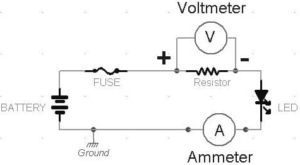Ammeter and voltmeter
An ammeter is an electrical device that is used to measure the current. It is the modified form of the galvanometer. It is a low-resistance galvanometer. It is always connected in series with the circuit to measure current. An ideal ammeter has zero resistance. While Voltmeter is an electrical device that is used to measure the potential difference between two points.


Meter movement
The portion of the galvanometer whose motion causes the needle of the device to move across the scale is usually known as meter-movement,
Mostly, the galvanometer gives full-scale deflection even when a few milliamperes current passes through it. So for large current measurements, it should be modified.
See also: Series and Parallel Circuits
Conservation of galvanometer into Ammeter
Shunt (bypass) resistor
A galvanometer can be converted into an ammeter by connecting a low resistance Rs called shunt (bypass) resistor in parallel with the meter-movement (coil) of the galvanometer.
Range of Ammeter
Let, I be the range of the ammeter.
See also: Emf Vs P.D
Calculation of Shunt Resistance
Shunt resistance provides another path for the flow of current. The value of Rs is so adjusted that the current which gives full-scale deflection passes through the galvanometer and the remaining current passes through the Rs.
Let
The resistance of galvanometer = Rg
Full-scale deflection current = Ig
The current passing through Rs = I – Ig
Now, the potential difference across the Rg is:
Vg = Ig Rg ————- (1)
Similarly, the potential difference across the Rs is:
Vs = Ig Rs
Vs = (I – Ig) Rs ———— (2)
Since the galvanometer resistance, Rg, and the shunt resistance Rs are connected in parallel, so the potential difference between them must be the same i.e.,
Vs = Vg
Putting values, we get:
(I – Ig) Rs = Ig Rg
Or
Rs = Ig Rg/ (I – Ig) —————- (3)
The value of the shunt Rs is very small. We can use copper wire for this purpose which should be connected in parallel across the galvanometer. In order to increase the range of the ammeter, Rs should be decreased.
See also: Resistance
What is voltmeter?
The voltmeter is an electrical device that is used to measure the potential difference between two points. it is the modified form of the galvanometer. It is a high-resistance galvanometer. It is always connected in parallel with the circuit component. An ideal voltmeter has infinite resistance.
Conservation of galvanometer into Voltmeter
High Resistance
A galvanometer can be converted into a voltmeter by connecting a very high resistance Rh in series with meter-movement (coil) of the galvanometer.
Range of voltmeter
Let, the range of the voltmeter n= V (volts)
Calculation of High resistance (Rh)
The value of the high resistance Rh should be such that the galvanometer gives full-scale deflection when it is connected to V volt.
Let,
The resistance of meter-movement = Rg
Full scale deflection current = Ig
Since Rg and Rh are in series, so
The combined resistance of the meter movement and Rh = Rg + Rh
Applying Ohm’s law, we have
V = Ig (Rg + Rh)
V = Ig Rg+ Ig Rh
Or Ig Rh = V – Ig Rg
Or Rh = V/Ig – Rg
This equation gives the value of the high resistance Rh which is used to convert the galvanometer into the voltmeter. The scale is calibrated from 0 to V to measure the voltage. In order to increase the range of the voltmeter, Rh should be increased.
The resistance of the voltmeter should be greater than the circuit resistance otherwise it will change the value of potential difference which is to be measured.
Related Topics:
Recent Posts
Difference between Gastritis and ulcer
Gastritis and ulcers are irritations, which must be treated urgently in order not to develop…
Saudi Arabia launches new residency plans to draw foreign talent
On Thursday, Saudi Arabia unveiled fresh residency programs geared towards drawing in skilled professionals and…
Study in UAE: Your Complete Guide to Enrolling Abroad
Studying abroad can be a life-changing experience, opening doors to new cultures, perspectives, and opportunities.…
Difference between Osmosis and dialysis
The difference between osmosis and dialysis is that Osmosis is a physical phenomenon by…
Difference between Vitamins and proteins
The Difference between Vitamins and Proteins is given here. Vitamins and proteins are essential…
Difference between Windows and Linux
The Difference between Windows and Linux is given here. Windows and Linux are operating systems…